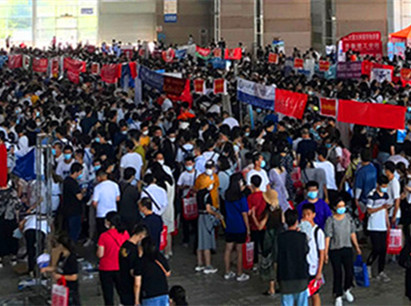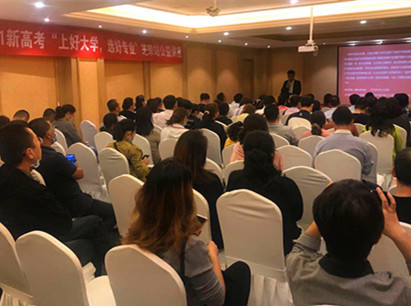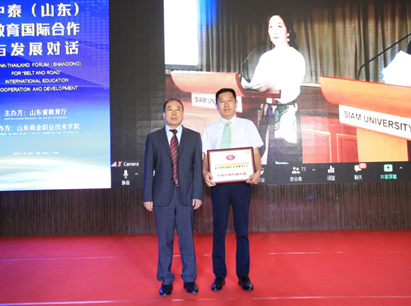发起商会
一 亚洲国际贸易投资商会
亚洲国际贸易投资商会经泰国商业部批准,合法成立。由泰国资深政治家、著名学者、企业界精英联合组成。致力于亚洲(10+6)新自贸区内的贸易与投资服务,旨在推动自贸区经济发展,促进文化交流。会员单位一千五百多家,来自各个行业。
近年来,随着中国“一带一路”倡议及中国东盟自贸区升级版的打造,商会加强了与中国各行业的互动交流。培养了诸多商会品牌:
品牌活动之一—“东盟市场分析说明会”每年举办十几场,累计举办100 余场。参加企业超千家,好评如潮,反响热烈。
品牌活动之二—“泰国品牌中国行” 每年组织数百家会员企业参加中国各类博览会,累计在中国组织60余场。
品牌活动之三—“东盟(曼谷)中国进出口商品博览会” 已成功举办9届,累计中国参展企业近2000家。
在 2013-2014 年度泰国商业部商会工作评比中,商会以组织活动、服务质量、内部管理、发展潜力四项指标全部第一的最佳殊绩,荣获年度“特优商会”称号。2015 年,商会非常荣幸的被泰国政府选择为战略合作伙伴,在巴育总理见证下,在总理府签订合作协议。在 2015-2016 年度泰国商业部商会工作评比中,商会囊括“特优商会”、“优秀商会管理者奖(主席)”、“优秀商会理事会”三大奖项。2016-2017 年度泰国商业部商会工作评比中,再次评为“特优商会”。创造了泰国商业部评优史上唯一一家连续3年评为“特优商会”的纪录。
4、亚洲国际贸易投资商会教育专业委员会简介
随着中泰及中国东盟经贸往来的日益紧密,大大促进了双方人文、教育的交流合作。为顺应时代发展趋势,加强“一带一路”沿线各国高等教育之间的合作,聚力构建 “一带一路”教育共同体,促进区域教育发展,服务中泰教育在国际化人才培养、境外办学、教育学术交流等方面寻找合作机会,在泰国教育部及教育界同仁的大力支持下,2018年商会成立教育专业委员会。以“搭建合作平台、服务教育同行”为宗旨,提升中泰教育交流与合作质量。
2018年11月10-14日,首届“中泰高等教育项目合作洽谈会”在曼谷成功举办,来自中泰两国50余所高校,就中泰教育合作中的经验、问题及趋势进行了广泛交流与探讨。会后,我们对参会院校进行成果跟进调研,已有部分院校达成了合作办学的意向,获得良好社会效益。
二 泰国大学校长理事会
The Council of University President of Thailand (CUPT) was established with the collaboration of universities in order to help each other’s handling critical problems in those days. Currently, there are 27 universities/institutes. Originally, it is named as “Rectors Conference” and it was changed to “Council of University Presidents of Thailand” which is an independent organization founded under the collaboration of presidents of thai universities/higher education institutes. They mutually agreed upon the idea of meetings and sharing experiences and opinions among them and setting the CUPT to be a center of exchanging experiences and opinions, proposing initiative ideas about national higher education operations, and pushing forward those into reality.
According to the statement number 3 on the agreement of the meeting of university presidents in 1972, it reads, “the Council of University Presidents of Thailand (CUPT) would be the center to exchange opinions and to cooperate under common interest between universities/institutes, which were bound on this agreement”. The CUPT will NOT be a political organization. In September 1979 (the 6th meeting of 1979), the CUPT reviewed on the roles and reissued as follows:
The CUPT should be the place to provide collaboration and support universities development in many aspects but these would not overlap with the role of the Ministry of University Affairs (which now known as the Office of the Higher Education Commission – OHEC).
The CUPT should be a central organization of public universities in order to suggest and advise the Ministry of University Affairs and the government, including delivering related essential actions to the government in many aspects.
The CUPT must be an organization to set policy in the manner of actions or reflecting broad opinions in accord of beneficial issues or common problems among universities and offer suggestion to the government. While, issues that can be handled internally will be proceeded in collaborative among the network.
三 泰国皇家理工大学联合会
The Council of Rajamangala University of Technology Presidents (CRMUTPs) was established in accordance with the Rajamangala University of Technology Act, B.E. 2548 (2005), section 3, academic collaboration and resource usage as mentioned below:
Article 47: For the benefit of the academic collaboration and shared resources among RMUTs, the Committee of the Presidents of RMUTs consists of the presidents of the nine RMUTs
The meeting of the committee shall be in accordance with the regulations decided by the Committee in the article 48 which defines the power and duties as follows:
1) To propose and promote the plan regarding academic development, the academic collaboration and the shared resources to each RMUT,
2) To arrange the agreement between each RMUT regarding the academic collaboration and shared resources with the consent of each RMUT,
3) To arrange the agreement between each RMUT and both public and private vocational institutions regarding academic collaboration and vocational studies in higher education with the consent of each RMUT,
4) To determine the direction of the collaboration of each RMUT with the community, private sector, and municipality,
5) To form the committee or an individual to consider and to propose an idea on any matters arise, or to perform any actions which are under the authority or duties of the Committee of the Presidents of RMUTs.
Background and History of The Nine Rajamangala Universities of Technology
On February 27th, 1975, Institute of Technology and Vocational Education was established with the goals of (1) producing vocational teachers who are able to provide vocational education to vocational certificate students, high vocational certificate students and bachelor degree students, (2) promoting vocational study, and (3) providing vocational and academic services to the society.
On September 15th, 1988, His Majesty the King Bhumibol Adulyadej of Thailand gave the new name as “Rajamangala Institute of Technology”. On January 18th, 2005, “Rajamangala University Act” was enacted. More than 35 campuses of Rajamangala Institute across Thailand were divided into nine Rajamangala Universities of Technology as below:
1)RMUT Thanyaburi or RMUTT 2)RMUT Krungthep or RMUTK
3)RMUT Tawan-ok or RMUTTO 4)RMUT Phra Nakhon or RMUTP
5)RMUT Rattanakosin or RMUTR 6)RMUT Lanna or RMUTL
7)RMUT Srivijaya or RMUTSV 8)RMUT Suvarnabhumi or RMUTSB
9)RMUT Isan or RMUTI
wesite: www.eng.rmutt.ac.th
四 泰国私立高等教育商会
Association of Private Higher Education Institutions of Thailand
Under the Patronage of H.R.H Princess MahaChakriSirindhorn(APHEIT)
In Brief:
· Established in 1979, a juristic entity by Thai law. The objectives are to promote cooperation and collaboration among private higher education institutions and other educational institutions at home and abroad.
· The institutional purposes broadly speaking are to enhance the quality of educational services, including offering and seeking of advice from major sectors: government, business and industry with respect to the development of human resources that have essential skills and attitudes needed for the century.
· Currently, APHEIT has sixty four (64) institutional members: 41 universities, 6 institutes, 17 colleges, accounting for almost 90 % of the total.
· All private higher education institutions in Thailand are established and governed under the Private Higher Education Act.
· In principle, the strategic focus of private higher education degree programs is on producing professionals in different fields in response to the business and industry’s demand for manpower, including the 10 target industries under the policy Thailand 4.0.
· Proportion of undergraduate and post graduate degree programs: 70:30.
Medium of instruction: Thai, English, Chinese languages.
· The APHEIT Office is physically located in the complex of the Office of Higher Education Commission (OHEC) in Bangkok.
· website: www.apheit.org
五 泰国皇家师范大学联合会
The Rajabhat Universities (RTGS: Mahawitthayalai Ratchaphat) compose one of the university systems in Thailand. They were formerly called Rajabhat Institutes and originally formed the teachers college system. In 2005, King Bhumibol Adulyadej collectively elevated them to be universities. Many provinces have one—there are 38 total—and they are generally easier to gain admission to than the public universities (formerly the government universities). Most Rajabhat Universities offer graduate degrees, some even to the doctoral level. Enrollments have been shrinking. As of 2018, students numbered 540,000, down from 600,000. These institutions are equivalent to British polytechnics that have become universities. They face a similar challenge of matching the prestige of older institutions. They were conferred the royal word Rajabhat to possibly shield them from criticism and help raise their status.
List of Rajabhat Universities
Bangkok group 1.Bansomdejchaopraya Rajabhat University2.Chandrakasem Rajabhat University
3.Dhonburi Rajabhat University 4.Phranakhon Rajabhat University
5.Suan Sunandha Rajabhat University
6.Suan Dusit Rajabhat University (since 2015 change to Suan Dusit University)
Northern group 7.Chiang Mai Rajabhat University 8.Chiang Rai Rajabhat University
9.Kamphaeng Phet Rajabhat University 10.Lampang Rajabhat University
11.Nakhon Sawan Rajabhat University 12.Phetchabun Rajabhat University
13.Pibulsongkram Rajabhat University (Phitsanulok) 14.Uttaradit Rajabhat University
Northeastern group 15.Buriram Rajabhat University 16.Chaiyaphum Rajabhat University
17. Udon Thani Rajabhat University 18.Loei Rajabhat University
19.Maha Sarakham Rajabhat University 20.Nakhon Ratchasima Rajabhat University
21.Roi Et Rajabhat University 22.Sakon Nakhon Rajabhat University
23.Sisaket Rajabhat University 24.Surin Rajabhat University
25.Ubon Ratchathani Rajabhat University
26. Kalasin Rajabhat University (since 2016 combined to Kalasin University)
27.Nakhon Phanom Rajabhat University (since 2005 combined to Nakhon Phanom University)
Central group 28.Phranakhon Si Ayutthaya Rajabhat University (Ayutthaya)
29.Muban Chom Bung Rajabhat University (Chom Bung, Ratchaburi)
30.Kanchanaburi Rajabhat University 31.Nakhon Pathom Rajabhat University
32.Phetchaburi Rajabhat University 33.Rajanagarindra Rajabhat University (Chachoengsao)
34.Rambhaibarni Rajabhat University (Chanthaburi) 35.Thepsatri Rajabhat University (Lopburi)
36.Valaya-Alongkorn Rajabhat University (Khlong Luang, Pathum Thani)
Southern group
37.Nakhon Si Thammarat Rajabhat University 38.Phuket Rajabhat University
39.Songkhla Rajabhat University 40.Suratthani Rajabhat University
41.Yala Rajabhat University
Website: www.cupt.net
六 泰国职业教育商会
The Association of Private Colleges of Technology and Vocational Education of Thailand under the Patronage of Her Royal Highness Princess Maha Chakri Sirindhorn., was established in 1984 to promote Thailand’s private vocational education. With more than 400 institutional members throughout the kingdom, our missions are
1.Strengthening and promoting national education and vocational education provided by private sector.
2.Serving as the central organization for colleges of technology and vocational colleges to exchange knowledge and opinions, whilst collaborating with the government, Ministry of Education, related agencies and private sector to develop effective and efficient private vocational education.
3. Enhancing solidity and dialogues among executive boards, presidents, faculty staffs and students of vocational education institutions
4.Providing financial aids and other supplementary benefits for faculty staffs and students.
5.Enriching relationship with other educational associations and entities to promote efficient and effective vocational education.
6.Organizing activities and programs that enhance quality and competitiveness of our member institutions.
Website: www.pvet.or.th








